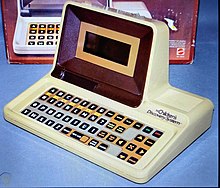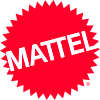Children's Discovery System
 | |
| Manufacturer | Mattel |
|---|---|
| Generation | Second |
| Release date | September 1981 |
| Discontinued | 1984 |
| Media | Learning Module ROM cartridges |
| Memory | 2k RAM |
| Display | LCD 16x48 |
| Input | Membrane keyboard |
The Mattel Children's Discovery System is an early electronic educational toy product released by Mattel in 1981. The Children's Discovery System was targeted toward children aged 6 to 11[1] and mimicked the look of a contemporary consumer-grade computer.
History
[edit]The system was developed by Mattel with the help of UCLA professor Dr. Gordon L. Berry, who was chief educational consultant on the project.[2]
It was announced at the American International Toy Fair in February 1981[3] and released later that year around October.[4][5] The system cost around $125 at launch.[6]
One review noted how small the screen resolution was, which limited it severely, and how slow the system was to start up. The included game modes on the console were also criticized: the type mode did not provide feedback on its word games, music mode was described as "pointless" due to its simplicity and that the music is represented by letter graphics instead of notes. The art mode, however, was praised for being a good introduction to computer graphics, although the process of drawing pixel-by-pixel was described as tedious.[7]
In September 1982, a marketing campaign was initiated with celebrity endorsement from the Smothers Brothers, claiming that the system could make parents "Get a smarter kid in 60 days. Or your money back", with purchase of the system and two modules made from September 1 to December 31, 1982.[8] In May 1984, Jell-O had 1000 units as part of a prize pool for a sweepstake until June 30.[9] In the Fall of 1984, Mattel liquidated the remaining 8000 units and learning modules to DAK Industries, where they sold through mail order a bundle that included the console with 14 learning modules for $79, nearly the entire library of games.[10] It later appeared in a Lionel Kiddie City sale in December 1985 for $29.91.[11]
Specifications
[edit]The Children's Discovery System used a 16-by-48 matrix LCD screen[12][13] and was powered by six size AA alkaline batteries.[14] The screen was much wider than it was tall, therefore only a grid of 8-by-2 text was possible, allowing for a maximum of 16 characters on-screen at any given moment.
The unit came preprogrammed with three modes: art mode, music mode and type mode. The Discovery System came with a specially laid-out membrane keyboard to better accommodate the built-in modes and also made use of keyboard overlays for use with expansion modules. Also included with the unit was a large activity book with over 100 suggested learning activities specially-tailored for the Discovery System.[15]
Expansion module cartridges
[edit]Besides the three included modes on the console, one could buy other game cartridges with different games. Each cartridge is numbered from 1 to 21, and all have the Discoveries in ---- Learning Fun Module name, where the ---- is the name of the actual game and what is written on the cartridge. Each module has several different modes for different games, and an age range depending on the content.
Although the system was advertised alongside 21 different modules since the beginning, all 21 were not ready at launch, with only 8 titles available by late 1982. Others were developed and released at later dates. It is currently unknown if all the modules were even developed or released.
Each box is a different color, and collecting them together creates a color gradient with the spines. Photos of different children are used in the front of each box.
- Background shading indicates the color of the box and number on the spine of each game.
| # | Code | Age range | Fun module | Game modes listed in the box |
|---|---|---|---|---|
| 1 | 1606 | 6–11 | Math I |
|
| 2 | 3349 | 6–11 | Arcade Action I |
|
| 3 | 1607 | 6–8 | Words I |
|
| 4 | 1609 | 6–11 | Art |
|
| 5 | 1608 | 6–11 | Music |
|
| 6 | 3346 | 9–11 | Words II |
|
| 7 | 3731 | 6–11 | Arcade Action II |
|
| 8 | 3733 | 6–11 | Memory And Logic |
|
| 9 | 3732 | 6–11 | Geography I |
|
| 10 | 3734 | 6–11 | Foods |
|
| 11 | 5165 | 6–8 | Fractions I |
|
| 12 | 3347 | 9–11 | Fractions II | |
| 13 | 3350 | 9–11 | Science I |
|
| 14 | 3835 | 6–11 | Presidents |
|
| 15 | Arcade Action III [16] | |||
| 16 | 5329 | Computer Programming | ||
| 17 | ||||
| 18 | 5328 | 9–13 | Spelling Fun |
|
| 19 | ||||
| 20 | ||||
| 21 |
Other games/unknown number:
- Math Quiz/Calculator
- Nutrition
- (4456) US Cities
- (3347) History
- (3348) Sports
References
[edit]- ^ "Mattel 1981 Toy Fair catalog". Handheld Game Museum.
- ^ "Computing Considerations". Personal Computing. February 1982. p. 88.
- ^ "Creative Computing Magazine (September 1981) Volume 07 Number 09". September 1981.
- ^ "The Philadelphia Inquirer 09 Oct 1981, page Page 39". The Philadelphia Inquirer. October 9, 1981.
- ^ "Daily News 07 Oct 1981, page 122". Daily News. October 7, 1981.
- ^ Freedman, Alix M. (15 November 1981). "ELECTRONIC GAMES: DO THEY HELP?". The New York Times. Retrieved 19 May 2022.
- ^ Staples, Betsy (December 1981). "Children's Discovery System". Creative Computing Magazine. Vol. 7, no. 4. pp. 60–64.
- ^ "St. Louis Post-Dispatch 15 Dec 1982, page Page 12". St. Louis Post-Dispatch. December 15, 1982.
- ^ "Times-Advocate 23 May 1984, page 47". Times-Advocate. May 23, 1984.
- ^ "Children's Discovery System". Fall 84. DAK Industries Incorporated. 1984.
- ^ "The Salt Lake Tribune 19 Dec 1985, page 57". The Salt Lake Tribune. December 19, 1985.
- ^ Edwards, Benj (June 26, 2011). "Kids' Computers Through the Ages". PCWorld. Retrieved 19 May 2022.
- ^ "The Great Game Database - Mattel Children's Discovery System". Archived from the original on 2011-07-11.
- ^ "Computer History Museum - The Children's Discovery System computerized learning system". Archived from the original on 2012-10-01. Retrieved 2008-08-30.
- ^ "Handheld Game Museum - Children's Discovery System (Mattel 1981 catalog)".
- ^ "MicroKids - Issue 01 Volume 01 No 01 (1983-12)(Microkids Publishing)(US)". December 1983.

